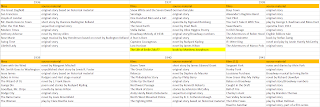One of the more common complaints about contemporary Hollywood is that they have run out of ideas and are only recycling already well-known materials and doing remakes and adaptations. It is not only a common complaint now, but it has almost always been a common complaint. Some claim that this is what ruined Hollywood in the late 1970s, that pre-packaged films based on famous books/comics/shows took over what had once been a place of original ideas. But as I pointed out in one of my articles about "New Hollywood" it has always been the case that Hollywood bought the rights to whatever was big and successful and made a film adaptation of it. There is nothing wrong with that, and it is not something that is unique to Hollywood, or to mainstream films. Cinema as an art form is to a large extent built on adapting stories already told in some other art form, whether novels, plays, short stories, songs, poems, essays, or other films. Bergman, Fassbinder, Akerman, Kurosawa, Visconti, Zetterling, Hitchcock, Ford, Tarkovsky, Hawks, Troell, Denis, Truffaut; they have all made films based on other material instead of original stories. That is not particularly interesting. It is what they do with the material that matters. And so it is in Hollywood at the height of the studio era. Continuing my project of investigating the period 1930 to 1945 (read introduction here), I will now take a look at this topic. How many of the box office hits from those years were adaptations, and what were they adapted from, and how many were original stories?
Here are the lists of all films, year for year, and what their source material was. (All the necessary caveats are presented here.) I make a distinction between novel and book, and use the latter when it is a work of non-fiction. The first list is 1930 to 1935, then 1936 to 1941, and then 1942 to 1945. Films marked with yellow are those I believe should be counted among the top ten box office hits of that year but I have not had it confirmed. The many films made in 1943 and 1944 explicitly to boost the morale of troops during World War 2 are difficult to classify.
Out of 166 films, 42% were original stories (70 films), making it the most common form. 50 were adaptations of books, 17 of plays, and 15 of short stories or novellas. The rest were based on other things, like radio shows or operettas. Most of those 17 adaptations of plays were made in the first half of the 1930s, after which they almost disappeared.
One thing to consider is that there is not much point in making distinctions between original stories and adaptations. The quality or originality of a given film is almost completely unrelated to that factor. It is not always easy to decide whether a film is an original story or not, as there are many layers and various factors involved. If a film is based on a novel but entirely rewritten so that all that remains are some characters and the setting, is it even relevant to call it an adaptation. What is an original story anyway? Above I have marked a film as an original story only if it has not got any specific source of any kind. But that does not mean that those stories are more original or that the others are less interesting or daring.
In an upcoming post I will compare the figures presented here with the Academy Award nominees for best film and see whether there are more, fewer, or the same amount of adaptations among them.
------------------------------------------------------
Previous posts in the 1930-1945 project are:
https://fredrikonfilm.blogspot.com/2021/03/1930-to-1945-by-numbers-part-i.html
https://fredrikonfilm.blogspot.com/2021/04/1930-to-1945-by-numbers-part-ii.html
https://fredrikonfilm.blogspot.com/2021/04/1930-to-1945-by-numbers-part-iii-actors.html
https://fredrikonfilm.blogspot.com/2021/06/1930-to-1945-by-numbers-part-iv-oscar.html



